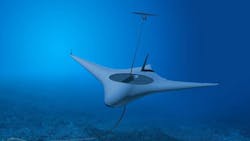Three U.S. contractors to develop energy management, navigation, for unmanned underwater vehicles (UUVs)
ARLINGTON, Va. – U.S. military researchers are asking three defense companies to develop enabling technologies for future large-size unmanned underwater vehicles (UUVs) with long endurance and large payload capacity.
Officials of the U.S. Defense Advanced Research Projects Agency (DARPA) in Arlington, Va., have awarded contracts to Lockheed Martin Corp., Northrop Grumman Corp., and Navatek LLC for the Manta Ray extra-large unmanned underwater vehicle project.
Manta Ray is to open a design space for future UUVs that are capable of long-duration missions and large payload capacity, as well as to advance key technologies that will benefit other naval designs such as low-cost UUV operations, long duration undersea energy management, biofouling reduction, and long-duration navigation.
The Lockheed Martin Advanced Technology Laboratories in Cherry Hill, N.J., won a $12.3 million Manta Ray contract Friday; the Northrop Grumman Mission Systems segment in Linthicum, Md., won a $10.1 million contract Monday, and Navatek in Honolulu won a $5.5 million contract on Monday.
Related: Unmanned submarines seen as key to dominating the world’s oceans
UUVs that operate for extended durations without the need for logistic support or maintenance from humans offer the potential for persistent operations in forward environments, DARPA officials explain. Such systems could enhance the flexibility of traditional manned host vessels by providing servicing ports and reduced workloads, officials say.
The Manta Ray program seeks to demonstrate critical technologies for a new class of long-duration, long-range, payload-capable UUVs to give extra capacity to military commanders without disrupting their operations. Key aspects of the Manta Ray program are classified.
The Manta Ray program seeks to develop key technologies in energy management for UUV operations; energy harvesting at submerged depths; low-power and high efficiency undersea propulsion; and low-power underwater detection and classification of hazards or counter detection threats.
The Manta Ray contractors also will investigate mission-management technologies for extended UUV operations; high-efficiency undersea navigation; and new ways to mitigate biofouling, corrosion, and other material degradation for long-duration missions.
The Manta Ray project will includes at-sea demonstration of critical technologies to define program goals and identify enabling technologies necessary for future systems. On these contracts Lockheed Martin, Northrop Grumman, and Navatek should be finished by January 2021.
For more information contact Lockheed Martin Advanced Technology Laboratories online at www.lockheedmartin.com, Northrop Grumman Mission Systems at www.northropgrumman.com, Navatek at www.navatekltd.com, or DARPA at www.darpa.mil.

